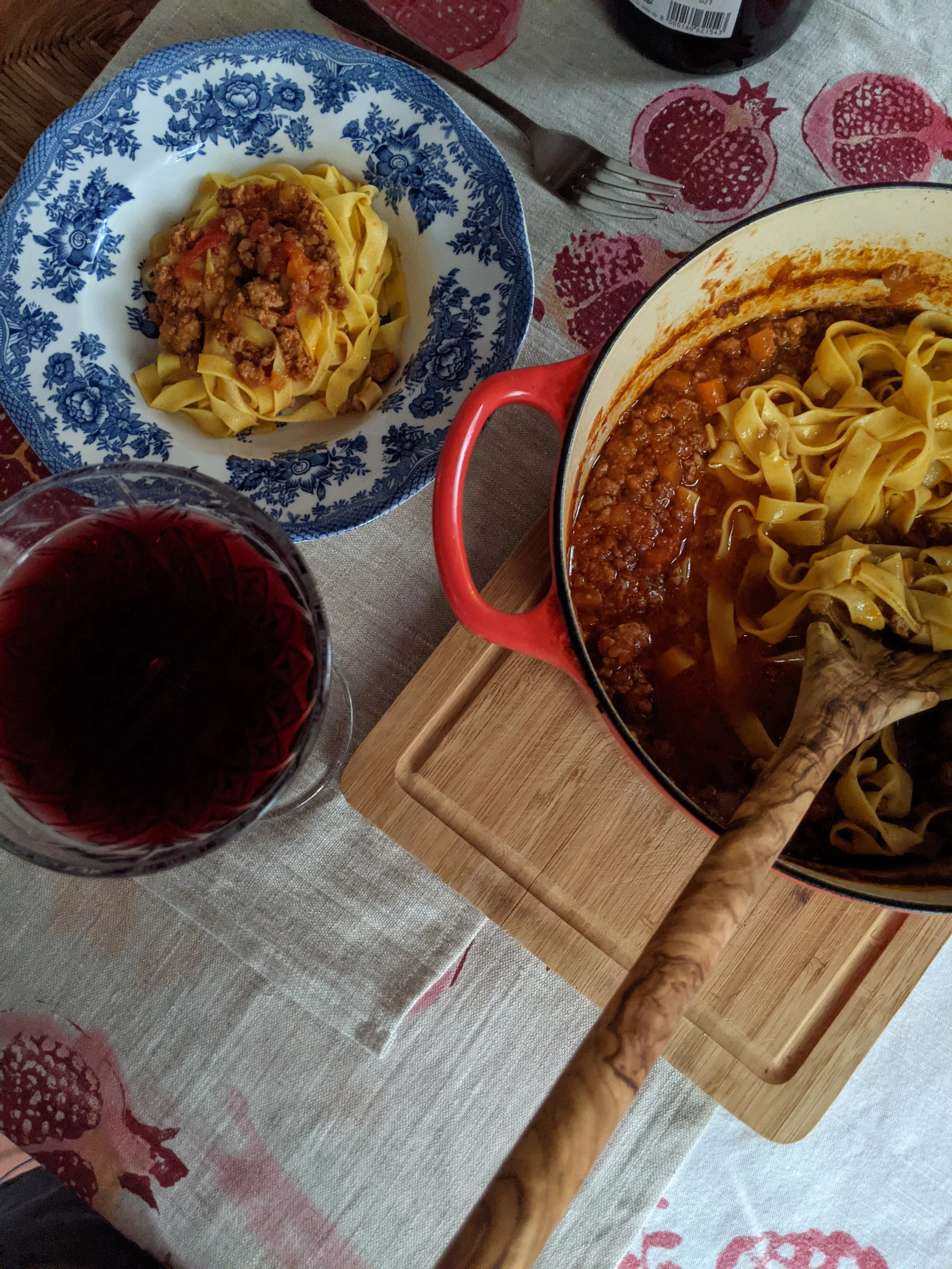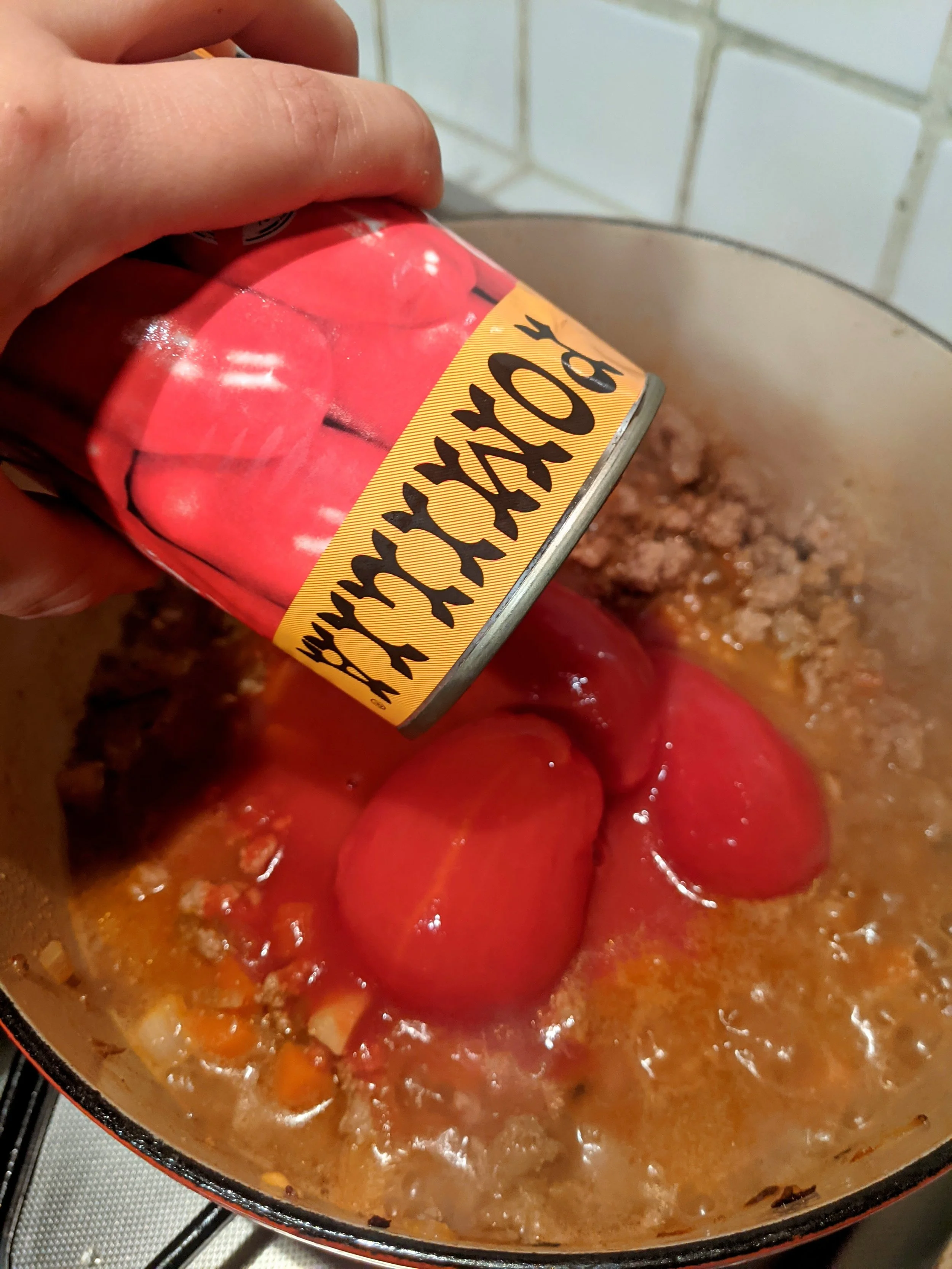Ragu Bolognese
Tagliatelle with Ragu Bolognese
With Valentine’s Day coming up thought I’d share my bolognese ragu recipe. I don’t follow recipes much, but way back I would try recipes I found online, cooking shows, and cookbooks. I tried many Italian cookbooks, but one of my favorites was Marcella Hazan’s, Essentials of Classic Italian Cooking.
Ragu is a sauce made with meat, whether it is ground meat, chunks of meat, or large cuts of meat like braciole or pork ribs. Every nonna has their recipe, and everyone will say their nonna’s is the best. Each region has slight variations to their ragu, some add pancetta or some chicken livers. Each area adds their own twist based on local specialty ingredients or traditions. The most famous type of ragu is Ragu Bolognese. It’s thought of as a Sunday sauce because it simmers for hours but you can really enjoy it any day of the week if you plan ahead. One thing is certain if you love someone make them this ragu recipe.
The first recipe I found of Marcella Hazan’s was published in The NY Times, she made a tomato sauce with whole peeled tomatoes, 5 tablespoons of butter, and half a red onion. You leave it in the pot, no chopping, minimal prep work and then you forget about it for 40 min. It’s not common to have tomato sauce with butter in all parts of Italy, and some get irate when I mention it to them in Tuscany but you don’t know what you’re missing until you’ve tried it.
After I tried that recipe I became fascinated with her and got a few of her cookbooks. The bolognese ragu recipe I make is inspired by hers. I say inspired as I started making it her way, and over time adjusted the recipe to my liking. I am linking her recipe that was posted in The New York Times if you would also like to give her classic Marcella recipe a try.
Ragu Bolognese
Serves 4
Ingredients:
1 carrot
1 celery
1 onion
200 gms (approx 1/2 an lb) ground chuck
200 gms (1/2 an lb) ground pork
1 Italian pork sausage
1 can of whole peeled tomatoes
1 TB tomato paste
1 to 2 cups milk
1 cup dry red wine
1 sprig rosemary
A few sprigs of thyme
1 bay leaf
A leftover rind of parmigiano (optional)
EVOO
Salt to taste
Note: Ragu Bolognese is typically made with tough cuts of meat that braise until tender. If you want to substitute the meat being used, go ahead just keep in mind if it’s a tough cut or lean cut of meat to adjust cooking time accordingly. You can personalize your ragu by adding your favorite herb if you want to use different ones. Dry red wine is usual for this, but if you have an open bottle of white or rose as long as it’s not sweet would be ok as well. I like to use whole peeled tomatoes, but crushed or pureed can also be used. People do get surprised about how little tomatoes this sauce has, but trust me it will turn out so tasty! I also make large amounts and end up freezing half the sauce. It freezes quite well and defrosts easily when you’re ready to use
Ragu Bolognese Mise en Place
Method:
Dice the celery, onions, and carrots. Feel free to dice as you see fit, as this is a matter of preference. It should be small to medium maximum, the larger the dice the more rustic. Some people dice it, sauté it and blend it so that it disappears into the sauce. I prefer something in the middle, a small dice along the lines of a brunoise.
In a medium pot drizzle some EVOO, and heat on low to medium flame. Add the soffritto and sauté until soft and caramelized. This will take about 10 minutes, you don’t want to burn it but you do want to build flavor by caramelizing the veggies. After the soffritto is done, add the tomato paste and stir well. Cook a few minutes to toast the tomato paste.
Simultaneously while the soffritto is cooking, in a skillet drizzle some EVOO and heat on low to medium. Add the ground meat and the sausage with casing removed. Cook until no longer pink, breaking up the meat as it cooks to a fine crumble. When it is no longer pink, cover it with milk and cook until the milk evaporates. Add the meat to the soffritto when the milk has evaporated, and stir well to combine the flavors.
Adding whole peeled tomatoes to the ragu
Now we are working with one pot, where you have caramelized soffritto and the ground meat that has been cooked with milk. Add the wine, and let the alcohol cook off. I test this by smelling the sauce, and you will notice the smell of strong alcohol when the wine is freshly poured gone. Add the whole peeled tomatoes. Rinse out the can of tomatoes to catch the remaining liquid and add enough water to just cover the meat. Add the bay leaf and parmigiano rind if using. I make a bouquet garnier with the herb sprigs by wrapping it in paper and tying it with twine. I add the bouquet garter to the sauce and tie it to the handle to easily fish it out at the end. From this point, the ragu will cook for 2 to 3 hours
While the meat braises it should be constantly covered in liquid to help soften the meat. By the time the ragu is done, it won’t be liquidy but during the cooking process, we need it to be quite liquidy. I use water as this is practical for me for a sauce that takes this long, but you can also use beef stock. Unless you are using a pressure cooker, it will take 2 to 3 hours to extract the collagen from the meat and allow it to soften. You will know it’s ready by taste. I constantly taste my ragu it’s cooking, and you will notice when the meat just gets really soft and falls apart. It’s almost impossible to overcook the ragu unless you are using very lean meat. I salt almost all my food, except for pasta cooking water, at the very end. Adjust salt to taste accordingly and serve with your favorite pasta. The very classic way is with some fresh tagliatelle, but it will be very good with just about any pasta you choose.
Freshly cut tagliatelle






